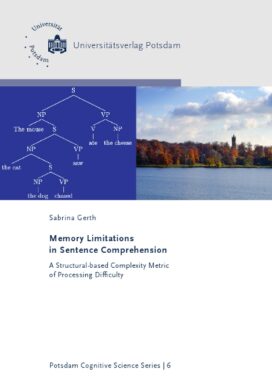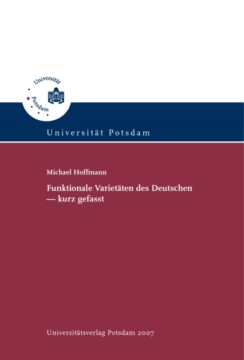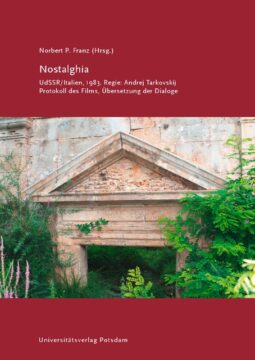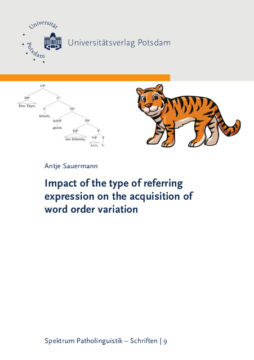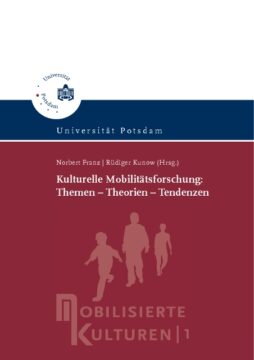This dissertation addresses the question of how linguistic structures can be represented in working memory. We propose a memory-based computational model that derives offline and online complexity profiles in terms of a top-down parser for minimalist grammars (Stabler,2011). The complexity metric reflects the amount of time an item is stored in memory. The presented architecture links grammatical representations stored in memory directly to the cognitive behavior by deriving predictions about sentence processing difficulty.
Results from five different sentence comprehension experiments were used to evaluate the model”s assumptions about memory limitations. The predictions of the complexity metric were compared to the locality (integration and storage) cost metric of Dependency Locality Theory (Gibson,2000). Both metrics make comparable offline and online predictions for four of the five phenomena. The key difference between the two metrics is that the proposed complexity metric accounts for the structural complexity of intervening material. In contrast, DLT”s integration cost metric considers the number of discourse referents, not the syntactic structural complexity.
We conclude that the syntactic analysis plays a significant role in memory requirements of parsing. An incremental top-down parser based on a grammar formalism easily computes offline and online complexity profiles, which can be used to derive predictions about sentence processing difficulty.
a structural-based complexity metric of processing difficulty
ISBN: 978-3-86956-321-3
175 pages
Release year 2015
Series: Potsdam Cognitive Science Series , 6
8,50 €
Non-taxable transaction according to § 1 (1) UStG/VAT Act in combination with § 2 (3) UStG/VAT Act a. F. Providing this service, the University of Potsdam does not constitute a Betrieb gewerblicher Art/Commercial Institution according to § 1 (1) No. 6 or § 4 KStG/Corporate Tax Act. If the legal characterization of our business is changed to a commercial institution subsequently, we reserve the right to invoice VAT additionally. zzgl. Versandkosten
This dissertation addresses the question of how linguistic structures can be represented in working memory. We propose a memory-based computational model that derives offline and online complexity profiles in terms of a top-down parser for minimalist grammars (Stabler,2011). The complexity metric reflects the amount of time an item is stored in memory. The presented architecture links grammatical representations stored in memory directly to the cognitive behavior by deriving predictions about sentence processing difficulty.
Results from five different sentence comprehension experiments were used to evaluate the model”s assumptions about memory limitations. The predictions of the complexity metric were compared to the locality (integration and storage) cost metric of Dependency Locality Theory (Gibson,2000). Both metrics make comparable offline and online predictions for four of the five phenomena. The key difference between the two metrics is that the proposed complexity metric accounts for the structural complexity of intervening material. In contrast, DLT”s integration cost metric considers the number of discourse referents, not the syntactic structural complexity.
We conclude that the syntactic analysis plays a significant role in memory requirements of parsing. An incremental top-down parser based on a grammar formalism easily computes offline and online complexity profiles, which can be used to derive predictions about sentence processing difficulty.
Recommended Books
-
 2007
2007Funktionale Varietäten des Deutschen – kurz gefasst
6,50 €Non-taxable transaction according to § 1 (1) UStG/VAT Act in combination with § 2 (3) UStG/VAT Act a. F. Providing this service, the University of Potsdam does not constitute a Betrieb gewerblicher Art/Commercial Institution according to § 1 (1) No. 6 or § 4 KStG/Corporate Tax Act. If the legal characterization of our business is changed to a commercial institution subsequently, we reserve the right to invoice VAT additionally.
zzgl. Versandkosten
Add to cart -
 2015
2015Nostalghia
11,50 €Non-taxable transaction according to § 1 (1) UStG/VAT Act in combination with § 2 (3) UStG/VAT Act a. F. Providing this service, the University of Potsdam does not constitute a Betrieb gewerblicher Art/Commercial Institution according to § 1 (1) No. 6 or § 4 KStG/Corporate Tax Act. If the legal characterization of our business is changed to a commercial institution subsequently, we reserve the right to invoice VAT additionally.
zzgl. Versandkosten
Add to cart -
 2016
2016Impact of the type of referring expression on the acquisition of word order variation
15,00 €Non-taxable transaction according to § 1 (1) UStG/VAT Act in combination with § 2 (3) UStG/VAT Act a. F. Providing this service, the University of Potsdam does not constitute a Betrieb gewerblicher Art/Commercial Institution according to § 1 (1) No. 6 or § 4 KStG/Corporate Tax Act. If the legal characterization of our business is changed to a commercial institution subsequently, we reserve the right to invoice VAT additionally.
zzgl. Versandkosten
Add to cart -
 2012
2012Norbert P. Franz, Rüdiger Kunow
Kulturelle Mobilitätsforschung
48,00 €Non-taxable transaction according to § 1 (1) UStG/VAT Act in combination with § 2 (3) UStG/VAT Act a. F. Providing this service, the University of Potsdam does not constitute a Betrieb gewerblicher Art/Commercial Institution according to § 1 (1) No. 6 or § 4 KStG/Corporate Tax Act. If the legal characterization of our business is changed to a commercial institution subsequently, we reserve the right to invoice VAT additionally.
zzgl. Versandkosten
Add to cart
Publisher Info
Contact
Potsdam University Library
University Press
Am Neuen Palais 10
14476 Potsdam
Germany
verlag@uni-potsdam.de
0331 977-2094
0331 977-2292

